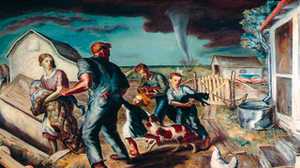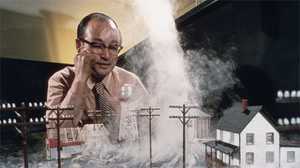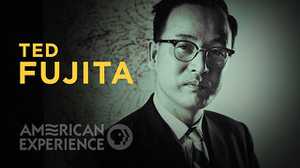The Remarkable Mind of Mr. Tornado
Tetsuya “Ted” Fujita’s unusual memoirs provide a fascinating glimpse into a one-of-a-kind mind.

Meteorologist Tetsuya “Ted” Fujita kept a lot of records. He recorded the prevalence of tornados in the United States by month and by state. He recorded the shapes of clouds. He recorded every airplane flight he ever took. On Memorial Day in 1987, he recorded his pulse, weight and blood pressure as they fluctuated throughout his waking hours, including stress tests with both a lawnmower and stationary bike, to conclude that his blood vessels expanded with warming body temperature and thus be able to explain the periodic drops in his systolic pressure rate.
For a half century, Fujita meticulously documented the research and ideas that animated his life, eventually combining them into an unorthodox autobiography. Memoirs of an Effort to Unlock the Mystery of Severe Storms During the 50 Years, 1942-1992 is a distillation of Dr. Ted Fujita, consummate researcher, rigorous data analyst and extreme-weather crime scene investigator. This fascinating document recounts the meteorological breakthroughs, for which Fujita would become famous, including the discovery of downbursts and microbursts—sudden disruptive airflows that could have fatal consequences—and the F-Scale measurement system that would earn him the nickname “Mr. Tornado.” But among the charts and graphs, his memoirs also reveal the story of a life, and a uniquely American life at that: one featuring immigration, reinvention and the generative possibility of chaos.
Born in Kitakyushu City, Japan in 1920, Fujita studied mechanical engineering, completing his doctorate from Tokyo University with an analytical study of typhoons. It was an unusual turn of events, however, that would determine his eventual professional path. In 1947, he recorded a severe thunderstorm from atop a mountain observatory in Japan. Years later, Fujita sent his subsequent analysis of that storm to a professor at the University of Chicago, so impressing him that Fujita was invited to continue his studies in the United States. With $22 in his pocket (the maximum amount, Fujita asserts in his memoir, that he was allowed to bring to the country due to post-war currency controls in Japan), he boarded his first flight ever and embarked on a new life.
Over the next three decades Fujita became a pioneer in the rapidly developing field of mesometeorology, the study of mid-scale atmospheric phenomena, such as tornados and hurricanes. He devised the internationally accepted standard for measuring tornado severity, developed and proved his controversial downburst theory and helped define the vocabulary with which we still describe extreme weather.
Memoirs of an Effort to Unlock the Mystery of Severe Storms is the sui generis product of an unusually curious person. Part cartography, part data visualization, part photo album, Fujita’s iconoclastic autobiography reveals a life dedicated to deciphering mysteries, both meteorological and personal.

In September 1945, Fujita traveled to Hiroshima and Nagasaki “to witness, among other things,” as he describes in his memoirs, “the effects of the shock wave on trees and structures.” Part of a Japanese research team investigating the effects of the nuclear bombs dropped by the U.S. on both cities, Fujita’s investigation evinced the kind of objectivity that would become a hallmark of his approach to catastrophic events throughout his career. Where another visitor might have had an emotional response to those sites of destruction, Fujita bore witness dispassionately, as a scientist.
One of the curious things Fujita observed was the same pattern of damage to vertical structures, such as poles and trees, at each site’s Ground Zero. All objects within the 100-150 km (62-93 mile) range of the blasts’ epicenter were left standing, but from 300-600 km (186-373 miles), poles and trees were broken off in giant starbust patterns. It was the same type of damage he would later see in a tornado’s path of destruction and then observe again at the site of a downed airplane. It was this keen observation that would later lead to his discovery of the thereto-unexplained downburst phenomenon, ultimately saving lives.

In August 1947, Fujita spent hours inside a leaky weather shack atop Seburi-yama Mountain in southern Japan, surrounded by lightning and 50-mile-per-hour winds and taking scrupulous measurements: of wind direction and speed, temperature, air pressure, dew point and other variables. After combining his data with those of other local weather stations, he developed complex weather maps of the storm, indicating high- and low-pressure fronts and the direction of wind movement. Fujita’s visualizations were far more information-dense and artful than other maps at the time. Through his study of the data, he also developed a theory: updrafts of warm air in thunderstorms were accompanied by cool, equally powerful downdrafts at their backsides.
When Fujita first released his findings they raised little interest, but at one presentation an attendee, an employee of Japan’s weather service, told him about reading an academic paper called “Nonfrontal Thunderstorms” that had been found in a trash can at a nearby U.S. Air Force radar base. The paper’s author, a University of Chicago professor named Horace Byers, had arrived at similar conclusions about the storms’ behavior, but with vastly more research resources at his disposal.
Fujita painstakingly translated his findings into English and sent Byers a copy, an act of initiative that led, as Fujita writes in his memoir, to his being “fished out of postwar Japan” to study in the United States. Taken by Fujita’s independent discovery of the downdraft phenomenon, Byers ultimately became the former’s “fatherly mentor professor.” An unlikely current of fate had redirected the course of Fujita’s life to America.

Fujita described his flight to the United States with typical matter-of-factness: “After the brake release at 1400 JST [Japan Standard Time], the Clipper accelerated rapidly and became airborne. I spoke to myself that I was now flying for the first time in my life. Without wasting the expensive flight time, I began sketching the vertical time cross section of clouds along the flight path. Shortly before 1600 JST, the aircraft flew into towering cumuli, encountering severe turbulence. I heard crashing sounds of dishes and utensils in the flight kitchen. A moment after, the flight became smooth and I saw a beautiful arc of low clouds.”

Over a 27-year period starting in 1965, Fujita flew out to more than 300 tornado sites, to view and photograph the storms’ aftermath from the sky. Seeing the marks left in a tornado’s path helped him to hypothesize the presence of suction vortices, a phenomenon whereby small but strong airflows orbit the core of a tornado, leaving litter and debris in visible patterns behind it. As handwriting reveals something of its scribe, the imprints tornados leave on the earth evince the behavior of their winds.
Fujita’s memoir contains galleries of such images that, seen in aggregate, demonstrate how meteorology is as much art as science. Without such a creative approach to a storm’s evidence, pattern recognition is much more difficult. “From [a] helicopter,” Fujita writes, “I found cycloidal marks in wheat fields, which were made visible by the sunlight scattering from the leaves of blown down wheat. The forward scattering light was strongest … In taking pictures of cycloidal marks in cornfields, we have to choose the best direction of view relative to the sun. Otherwise, one will see nothing from the air.”

Dr. Fujita was determined to devise a standardized method for reporting a tornado’s strength. Years of surveys carried out with his wife Sumiko and his team of grad students had amassed a trove of numerical, qualitative and material data to draw from. To create a snapshot of each storm, they collated onsite photographs at both ground and aerial levels with weather reports and survivor interviews.
In 1971, Fujita created his eponymous scale of tornado intensity, which he based on a storm’s peak windspeed and resulting damage. The classification system began at F0—corresponding to winds of 40-72 miles per hour with light damage—and went up to F5, with winds of 261 to 318 miles an hour and massive destruction.
The F-Scale was the product of years of meticulous, thorough work; its uptake as the international standard was the product of Fujita’s high profile. By the time of its development he had become the media’s go-to guy for severe storm analysis. Eventually his passion, knowledge and acumen for presenting meteorological information earned him the title “Mr. Tornado.”
Never content to rest on his earlier work, however, Fujita continued to evolve his ranking system—even after his retirement. In his memoir he included a revised scale, based upon the intervening two decades of research.


Road trips received the same treatment as sudden downbursts or suction vortices; they were catalogued and mapped in efficient infographic form. His preferred mode of ground travel was distinctly American. When he first arrived in the United States, Fujita didn’t know how to drive, but in 1956 he purchased a used car and, with tutelage, “got my driver’s license in two days,” he proudly reports in the memoir. Over the following decades he thoroughly explored his adopted homeland, driving through every state except for Rhode Island.

Fujita directed his considerable analytical talents inward as well as out, performing quantitative measurements of his life and times for pleasure: “I have always been interested in conducting observational experiments, large or small, making use of aircraft, radar, satellite, etc. I also like to collect my personal data and analyze them when I am tired of doing scientific research for too long.”
Fujita’s memoir reveals just how integral the analysis of data was to him as a meaning-making enterprise and in remaking himself as an American. “During the four postwar years in Japan,” he continues, “I experienced a 10,000% inflation rate. Keeping the bitter memory in mind, I worked on my own financial experiment from time to time while drinking glasses of beer.” Tracking the variance of several financial parameters over his lifetime was a way of understanding its arc, which had spanned so improbably from a small Japanese fishing village to a research directorship at a top American university, where he received his field’s highest honors. Ultimately, not even Mr. Tornado, himself, could arrive at a forensic method for understanding such existential mysteries.









